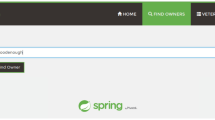Abstract
Requirements Analysis is the most important phase in Software development. It is a known fact now that if this phase is carried out properly the cost and effort of the project can be greatly reduced. Web applications are very important in today’s times. Effectively, every organization and even individual has a web application to represent itself. The Web applications have grown from just information providers to full-fledged legacy systems with complex processes. There are various methods of web application development, but hardly any method focuses on detailed requirements analysis that is required owing to the criticality of web applications. Goal oriented requirements engineering techniques have proven to be very effective in requirements analysis. Application of goal driven methodologies for web specific requirements can improve the quality of web applications besides saving cost and effort required in the project. The special characteristics of GORE techniques like analysis of softgoals and interdependencies between various requirements help in elimination of conflicts at early stages of web application development. GORE techniques also facilitate evaluation of goal models that helps in choosing amongst the design alternatives and checking completeness of the requirements model leading to Software Requirements Specification. The implementation of web specific goal driven framework is shown in the paper and validated through a usability survey.













Similar content being viewed by others
References
Bolchini D, Paolini P (2004) Goal-driven requirements analysis for hypermedia-intensive Web applications. Requir Eng J, RE’03 special issue (9), Springer, pp. 85–103
Busch M, Koch N (2009) MagicUWE–A case tool plugin for modeling web applications. In: Web engineering. Springer, Berlin, pp. 505–508
Castro J, Kolp M, Mylopoulos J (2002) Towards requirements-driven information systems engineering: the Tropos project. Inf Syst 27:365–389
Ceri S, Fraternali P, Bongio A (2000) Web modeling language (WebML): a modeling language for designing Web sites. Comput Netw 33(1):137–157
Chawla S, Srivastava S (2012) A Goal based methodology for Web specific requirements engineering. In: Information and communication technologies (WICT), 2012 World Congress on, pp. 173–178. IEEE
Chawla Shailey, Srivastava Sangeeta, Bedi Punam (2014) Evaluation of web-specific Goal oriented Requirements Language models with quantitative reasoning. ACM SIGSOFT Softw Eng Notes 39(2):1–9
Chung L, do Prado Leite JCS (2009) On non-functional requirements in software engineering. In: Borgida AT, Chaudhri VK, Giorgini P, Yu ES (eds) Conceptual modeling: foundations and applications. Springer, Berlin, pp 363–379
Cutter Consortium (2000) Poor project management number-one problem of outsourced E-projects, In: Cutter research briefs. http://www.cutter.com/research/2000/crb001107.html
Escalona MJ, Aragón G (2008) NDT. A model-driven approach for web requirements. IEEE Trans Softw Eng 34(3):377–390
Garrigós I, Mazón J-H, Trujillo J (2011) A Requirement analysis approach for using i* in web engineering, pp. 151–165, ICCSA 2011, LNCS, 2011, vol. 6786/2011, 421–436
Gordijn J, Yu E, van der Raadt B (2006) e-service design using i* and e3value modeling. IEEE Softw 23(3):26–33
http://news.netcraft.com/ Accessed on 12/2/2014
Koch N, Escalona M (2004) Requirements engineering for web applications—a comparative study. J Web Eng 2(3):193–212
Koch N, Knapp A, Zhang G, Baumeister H (2008) UML-based web engineering. In: Rossi G, Pastor O, Schwabe D, Olsina L (eds) Web engineering: modelling and implementing web applications. Springer, London, pp 157–191
Lewis JR (1995) IBM computer usability satisfaction questionnaires: psychometric evaluation and instructions for use. Int J Hum Comput Interact 7(1):57–78
Murugesan S, Deshpande Y, Hansen S, Ginige A (1999) Web engineering: a new discipline for development of web-based systems. In: Proceedings of the first international conference of software engineering (ICSE) workshop on web engineering, Los Angeles, USA
Roy J-F, Kealey J, Amyot D (2006) Towards integrated tool support for the user requirements notation. In: SAM 2006: fifth workshop on system analysis and modelling, LNCS 4320, Springer, pp. 198–215, http://jucmnav.softwareengineering.ca/
Schwabe D, de Almeida Pontes R, Moura I (1999) OOHDM-Web: an environment for implementation of hypermedia applications in the WWW. ACM SigWEB Newslett 8(2):18–34
Srivastava S (2014a) Model transformation approach for a goal oriented requirements engineering based WebGRL to design models. Int J Soft Comput Eng (IJSCE) 3(6):66–75
Srivastava S (2014b) A systematic approach towards transformation of presentation web Goal oriented Requirements Language to presentation design model. Int J Sci Eng Res 5(10):7–17. http://www.ijser.org
Van Lamsweerde A (2001) Goal-oriented require ements engineering: a guided tour. In: Requirements engineering, 2001. Proceedings. Fifth IEEE international symposium on (pp. 249–262). IEEE
van Lamsweerde A (2008) Requirements engineering: from craft to discipline. In: Proceedings of 16th ACM SigSoft international symposium on the foundations of software engineering (FSE’2008), Atlanta, USA
Z.151: User Requirements Notation (URN)—Language definition Recommendation Z.151 (10/12) Approved in 2012–2010
Author information
Authors and Affiliations
Corresponding author
Rights and permissions
About this article
Cite this article
Chawla, S., Srivastava, S. & Bedi, P. Improving the quality of web applications with web specific goal driven requirements engineering. Int J Syst Assur Eng Manag 8 (Suppl 1), 65–77 (2017). https://doi.org/10.1007/s13198-015-0385-z
Received:
Revised:
Published:
Issue Date:
DOI: https://doi.org/10.1007/s13198-015-0385-z




